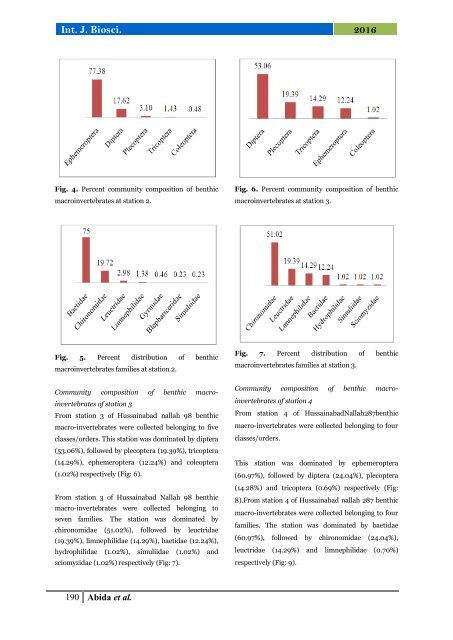Relative abundance of benthic Macro-invertebrates in relation to abiotic environment in Hussainabad nallah, Hunza, Gilgit Baltistan, Pakistan
Benthic macro-invertebrates have been extensively used as bio-indicators of ecosystem structure. The presence of particular species, taxa or community in the ecosystem reflects the history of that environment as well as the condition of that area. The samples of macro-invertebrates were collected from Hussainabad nallah on 26th April 2014 with the help of D-frame kick net. Total of five stations were selected keeping in view the accessibility to stations. At each station 100 meter area was allocated which was further divided in to five sub stations. A total of 930 macro invertebrates were collected from Hussainabad nallah. Highest density of macro-invertebrates were recorded from Station 2 (45.16%) followed by station 4 (30.86%), station1 (10.75%), station 3 (10.53%) and station 5 (2.68%) respectively. Hussainabad nallah was dominated by ephemeroptera (57.82%), followed by diptera (27.96%), plecoptera (9.68%), tricoptera (3.01%) and coleoptera (0.54%). Highest percentage of ephemeroptera is an indication for fresh environment. The mean value of turbidity was (7.03NTU), pH (6.88), temperature (14oC) and conductivity (372μS/cm) at Hussainabad nallah. Our findings indicated that, the most abundant macro-invertebrate fauna in Hussainabad nallah was ephemeroptera; that may lead to the fact that this order flourish well in fresh environment.
Benthic macro-invertebrates have been extensively used as bio-indicators of ecosystem structure. The presence of particular species, taxa or community in the ecosystem reflects the history of that environment as well as the condition of that area. The samples of macro-invertebrates were collected from Hussainabad nallah on 26th April
2014 with the help of D-frame kick net. Total of five stations were selected keeping in view the accessibility to stations. At each station 100 meter area was allocated which was further divided in to five sub stations. A total of 930 macro invertebrates were collected from Hussainabad nallah. Highest density of macro-invertebrates were
recorded from Station 2 (45.16%) followed by station 4 (30.86%), station1 (10.75%), station 3 (10.53%) and station 5 (2.68%) respectively. Hussainabad nallah was dominated by ephemeroptera (57.82%), followed by diptera (27.96%), plecoptera (9.68%), tricoptera (3.01%) and coleoptera (0.54%). Highest percentage of
ephemeroptera is an indication for fresh environment. The mean value of turbidity was (7.03NTU), pH (6.88), temperature (14oC) and conductivity (372μS/cm) at Hussainabad nallah. Our findings indicated that, the most abundant macro-invertebrate fauna in Hussainabad nallah was ephemeroptera; that may lead to the fact that this order flourish well in fresh environment.
- No tags were found...
You also want an ePaper? Increase the reach of your titles
YUMPU automatically turns print PDFs into web optimized ePapers that Google loves.
Int. J. Biosci. 2016<br />
Fig. 4. Percent community composition <strong>of</strong> <strong>benthic</strong><br />
macro<strong><strong>in</strong>vertebrates</strong> at station 2.<br />
Fig. 6. Percent community composition <strong>of</strong> <strong>benthic</strong><br />
macro<strong><strong>in</strong>vertebrates</strong> at station 3.<br />
Fig. 5. Percent distribution <strong>of</strong> <strong>benthic</strong><br />
macro<strong><strong>in</strong>vertebrates</strong> families at station 2.<br />
Community composition <strong>of</strong> <strong>benthic</strong> macro<strong><strong>in</strong>vertebrates</strong><br />
<strong>of</strong> station 3<br />
From station 3 <strong>of</strong> Hussa<strong>in</strong>abad <strong>nallah</strong> 98 <strong>benthic</strong><br />
macro-<strong><strong>in</strong>vertebrates</strong> were collected belong<strong>in</strong>g <strong>to</strong> five<br />
classes/orders. This station was dom<strong>in</strong>ated by diptera<br />
(53.06%), followed by plecoptera (19.39%), tricoptera<br />
(14.29%), ephemeroptera (12.24%) and coleoptera<br />
(1.02%) respectively (Fig: 6).<br />
From station 3 <strong>of</strong> Hussa<strong>in</strong>abad Nallah 98 <strong>benthic</strong><br />
macro-<strong><strong>in</strong>vertebrates</strong> were collected belong<strong>in</strong>g <strong>to</strong><br />
seven families. The station was dom<strong>in</strong>ated by<br />
chironomidae (51.02%), followed by leuctridae<br />
(19.39%), limnephilidae (14.29%), baetidae (12.24%),<br />
hydrophilidae (1.02%), simuliidae (1.02%) and<br />
sciomyzidae (1.02%) respectively (Fig: 7).<br />
Fig. 7. Percent distribution <strong>of</strong> <strong>benthic</strong><br />
macro<strong><strong>in</strong>vertebrates</strong> families at station 3.<br />
Community composition <strong>of</strong> <strong>benthic</strong> macro<strong><strong>in</strong>vertebrates</strong><br />
<strong>of</strong> station 4<br />
From station 4 <strong>of</strong> Hussa<strong>in</strong>abadNallah287<strong>benthic</strong><br />
macro-<strong><strong>in</strong>vertebrates</strong> were collected belong<strong>in</strong>g <strong>to</strong> four<br />
classes/orders.<br />
This station was dom<strong>in</strong>ated by ephemeroptera<br />
(60.97%), followed by diptera (24.04%), plecoptera<br />
(14.28%) and tricoptera (0.69%) respectively (Fig:<br />
8).From station 4 <strong>of</strong> Hussa<strong>in</strong>abad <strong>nallah</strong> 287 <strong>benthic</strong><br />
macro-<strong><strong>in</strong>vertebrates</strong> were collected belong<strong>in</strong>g <strong>to</strong> four<br />
families. The station was dom<strong>in</strong>ated by baetidae<br />
(60.97%), followed by chironomidae (24.04%),<br />
leuctridae (14.29%) and limnephilidae (0.70%)<br />
respectively (Fig: 9).<br />
190 Abida et al.


















